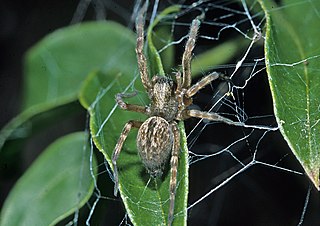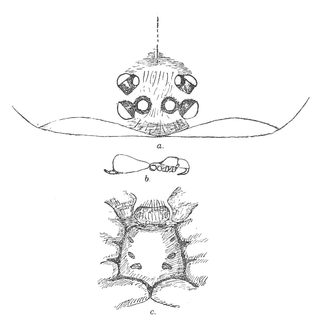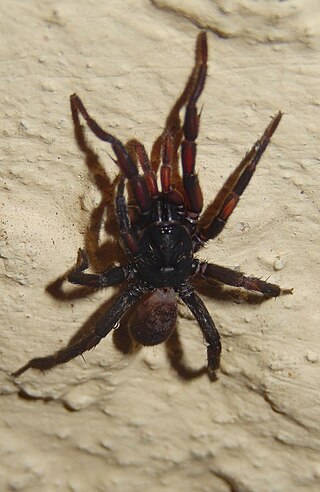
Lomatia tasmanica, commonly known as King's lomatia, is a shrub of the family Proteaceae native to Tasmania. Growing up to 8 metres (26 ft) tall, the plant has shiny green pinnate (lobed) leaves and bears red flowers in the summer, but yields neither fruit nor seeds. King's lomatia is unusual because all of the remaining plants are genetically identical clones. Because it has three sets of chromosomes and is therefore sterile, reproduction occurs only vegetatively: when a branch falls, that branch grows new roots, establishing a new plant that is genetically identical to its parent.

Amaurobiidae is a family of three-clawed cribellate or ecribellate spiders found in crevices and hollows or under stones where they build retreats, and are often collected in pitfall traps. Unlidded burrows are sometimes quite obvious in crusty, loamy soil. They are difficult to distinguish from related spiders in other families, especially Agelenidae, Desidae and Amphinectidae. Their intra- and interfamilial relationships are contentious. According to the World Spider Catalog, 2023, the family Amaurobiidae includes 286 species in 50 genera.

Nemesiidae is a family of mygalomorph spiders first described by Eugène Simon in 1889, and raised to family status in 1985. Before becoming its own family, it was considered part of "Dipluridae". The family is sometimes referred to as wishbone spiders due to the shape of their burrows.

Badumna is a genus of intertidal spiders that was first described by Tamerlan Thorell in 1890. They are harmless spiders that can be found around human structures and buildings. The most well-known species is B. insignis, also known as the "black house spider" or "black window spider".

Aname is a genus of mygalomorph spiders. It is endemic to Australia. The spiders, as well as some in closely related genera, are also known as wishbone spiders.

Aname atra, the black wishbone spider, is a mygalomorph spider of Southern Australia. It is one of the wishbone spiders in the taxonomic family Anamidae, found in varied habitats throughout Australia, including Tasmania. The most common species are the mottled eastern wishbones in the genus Namea, found in rainforests, black wishbones in the genus Aname, found in drier parts of Queensland, and the bearded wishbone, Xamiatus magnificus, also found in Queensland.
Aname diversicolor, the black wishbone spider, is a species of burrowing arachnid found in southern Australia.

Stanwellia is a genus of South Pacific mygalomorph spiders in the family Pycnothelidae. It was first described by W. J. Rainbow & R. H. Pulleine in 1918. Originally placed with the curtain-web spiders, it was transferred to the funnel-web trapdoor spiders in 1985, then to the Pycnothelidae in 2020. It is a senior synonym of Aparua.

Cantuaria is a genus of South Pacific armored trapdoor spiders that was first described by Henry Roughton Hogg in 1902. From 1985 to 2006 it was merged with former genus Misgolas, now Arbanitis.
Odostomia tasmanica, common name the Tasmania pyramid-shell, is a species of sea snail, a marine gastropod mollusc in the family Pyramidellidae, the pyrams and their allies.

Anamidae is a family of Australian mygalomorph spiders. It was first described as a tribe by Simon in 1889, then raised to the subfamily Anaminae of the family Nemesiidae, before being raised to a family level by Opatova et al. in 2020.
Heteromigas dovei is a species of tree trapdoor spider in the Migidae family. It is endemic to Australia. It was described in 1902 by British arachnologist Henry Roughton Hogg.
Aname coenosa is a species of mygalomorph spider in the Anamidae family. It is endemic to Australia. It was described in 1918 by Australian arachnologists William Joseph Rainbow and Robert Henry Pulleine.
Aname robertsorum is a species of mygalomorph spider in the Anamidae family. It is endemic to Australia. It was described in 1985 by Australian arachnologist Robert Raven.
Aname nitidimarina is a species of mygalomorph spider in the Anamidae family. It is endemic to Australia. It was described in 2020 by Mark Castalanelli, Volker Framenau, Joel Huey, Mia Hillyer and Mark Harvey.
Aname exulans is a species of mygalomorph spider in the Anamidae family. It is endemic to Australia. It was described in 2020 by Mark Harvey, Karl Gruber, Mia Hillyer and Joel Huey. The specific epithet exulans refers to its restricted offshore island distribution.
Aname elegans is a species of mygalomorph spider in the Anamidae family. It is endemic to Australia. It was described in 2022 by Mark Harvey, Jeremy Wilson and Michael Rix.
Aname pulchella is a species of mygalomorph spider in the Anamidae family. It is endemic to Australia. It was described in 2022 by Mark Harvey, Jeremy Wilson and Michael Rix.
Cryptoforis tasmanica is a species of mygalomorph spider in the Idiopidae family. It is endemic to Australia. It was described in 1928 by Australian arachnologist Vernon Victor Hickman. The specific epithet tasmanica refers to the species’ range.








